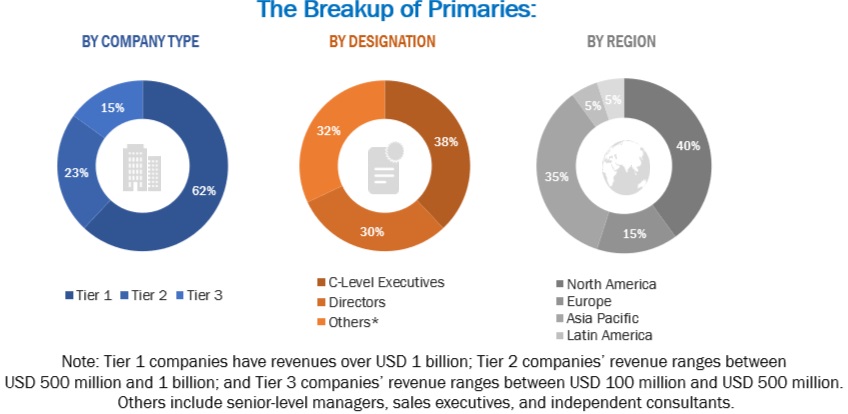The study involved four major activities in estimating the current size of the global LBS and RTLS market. Exhaustive secondary research collected information on the market, peer, and parent markets. The next step was to validate these findings, assumptions, and sizing with industry experts across the value chain through primary research. Both top-down and bottom-up approaches were employed to estimate the total LBS and RTLS market size. After that, the market breakup and data triangulation techniques were used to estimate the market size of segments and subsegments.
Secondary Research
In the secondary research process, various secondary sources, such as Bloomberg and BusinessWeek, have been referred to identify and collect information for this study. The secondary sources included annual reports, press releases, and investor presentations of companies; white papers; journals, such as Linux Journal and Container Journal; and articles from recognized authors, directories, and databases.
Primary Research
Various primary sources from the supply and demand sides were interviewed to obtain qualitative and quantitative information for this report. The primary sources from the supply side included industry experts, such as Chief Executive Officers (CEOs), Chief Marketing Officers (CMO), Vice Presidents (VPs), Managing Directors (MDs), technology and innovation directors, and related key executives from various key companies and organizations operating in the LBS and RTLS market along with the associated service providers, and system integrators working in the targeted regions. All possible parameters that affect the market covered in this research study have been accounted for, viewed in extensive detail, verified through primary research, and analyzed to get the final quantitative and qualitative data. Following is the breakup of primary respondents.

To know about the assumptions considered for the study, download the pdf brochure
Market Size Estimation
The top-down and bottom-up approaches were used to estimate and forecast the LBS, RTLS, and other dependent submarkets. The bottom-up procedure was used to arrive at the overall market size of the global LBS and RTLS market using key companies’ revenue and their offerings in the market. The research methodology used to estimate the market size includes the following:
-
Extensive secondary research has identified the key LBS and RTLS market players.
-
Regarding value, the market size has been determined through primary and secondary research processes.
-
All percentage shares, splits, and breakups have been determined using secondary sources and verified through primary sources.
LBS and RTLS market Size: Bottom-Up Approach

To know about the assumptions considered for the study, Request for Free Sample Report
LBS and RTLS market Size: Top-Down Approach

Data Triangulation
With data triangulation and validation through primary interviews, this study determined and confirmed the exact value of the overall parent market size. The overall market size was then used in the top-down procedure to estimate the size of other individual markets via percentage splits of the market segmentation.
Market Definition
Location-Based Services (LBS) can be defined as an information service provided by a device that delivers and updates information related to the location of the device as and when required. Implementing LBS requires the software application of a service provider, network and mobile-device-based technology, and a content provider for geo-specific information.
Real-Time Location Systems (RTLS) are local positioning and tracking systems that automatically locate and identify objects, people, or targets in real-time. RTLS systems are usually used indoors or within a building or other areas. RTLS tags, badges, or sensors attached to objects or worn by people communicate wirelessly with fixed receivers, readers, trackers, exciters, reference points, or access points installed nearby.
Key Stakeholders
-
LBS application developers
-
LBS and RTLS software/service providers
-
Network connectivity providers
-
Wireless infrastructure providers
-
Mobile content developers and aggregators
-
Smart devices and consumer electronics manufacturers
-
Venture capitalists, private equity firms, and startups
-
Government bodies, such as regulating authorities and policymakers
-
LBS and RTLS-related associations, organizations, forums, and alliances
Report Objectives
-
To determine, segment, and forecast the global LBS and RTLS market based on offering, service, location type, application, technology, vertical, and region in terms of value.
-
To forecast the size of the market segments to five main regions: North America, Europe, Asia Pacific, Middle East and Africa, and Latin America.
-
To provide detailed information about the major factors (drivers, opportunities, threats, and challenges) influencing the growth of the market.
-
To study the complete value chain and related industry segments and perform a value chain analysis of the market landscape.
-
To strategically analyze the macro and micro markets to individual growth trends, prospects, and contributions to the total market.
-
To analyze the industry trends, patents, and innovations related to the market.
-
To analyze the opportunities for stakeholders by identifying the high-growth segments of the LBS and RTLS market.
-
To profile the key players in the market and comprehensively analyze their market share/ranking and core competencies.
-
Track and analyze competitive developments, such as mergers and acquisitions, product launches and developments, partnerships, agreements, collaborations, business expansions, and Research and development (R&D) activities.
Available Customizations
With the given market data, MarketsandMarkets offers customizations per the company’s specific needs. The following customization options are available for the report:
Company Information
-
Detailed analysis and profiling of an additional two market players



Growth opportunities and latent adjacency in Location-based Services (LBS) and Real-Time Location Systems (RTLS) Market